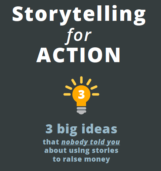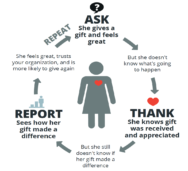Fundraising Season is beginning . . . and you’re going to write to your donors a LOT in the next few months. And I have an important tip for you.
Don’t assume your donors will read what you write.
Donors are moving fast (especially in their inbox). They are busy. They support multiple charities. And they don’t have to read your organization’s communications.
Right? Nothing bad happens to your donors if they don’t read your stuff. Their life just goes on. And as a matter of fact they’ve saved themselves some time.
So what is a nonprofit writer to do?
In almost all cases you have to earn their attention by being relevant and getting to the point quickly.
So pay special attention to your first sentence. Think of it this way: your first sentence has to earn your reader’s attention enough so that they want to read your second sentence.
I use two main strategies to get more people to read our clients’ fundraising materials:
#1 Very quickly state the point of your letter/email/brochure. Why are you writing the donor today? If you want the donor to do something, say it clearly right away.
We’ve improved the fundraising results for hundreds of organizations just by helping their fundraising materials get to the point faster. Because most nonprofits seem to assume that their donors will read the whole thing. So, they take a long time to get to the point, and then they only mention the point once.
My operating principle is that maybe 10% of donors will read it, but 50% of people will skim it IF you give them something interesting/urgent/valuable enough to skim.
Note those percentages don’t add up to 100%. That’s because no matter what you do, a significant percentage of donors are either going to miss or not read each message you send out. And that, my friend, is why nonprofits need to communicate more often than they think they do. Because most nonprofits assume every donor receives and reads every message. That’s a long way from what actually happens.
OK. The second way I get people to read is to use drama and tension.
#2 Write such a drama-filled first sentence that the reader really wants to know what the second sentence says.
Pick right up in the middle of the beneficiary story you’re telling. Or summarize the most drama-filled moment. But use emotion to get a reader curious about what happens next.
Here’s a great example, “When the police rang the doorbell, Gloria didn’t know what she was going to do.” This works for even the most boring subjects! “Our fiscal year end is approaching and I don’t think we’re going to make budget” is the opening line of one of the most successful letters I ever wrote.
So when you’re writing this fall, remember that your donors are busy and moving fast. Pay special attention to the very first sentences of anything you put out there. And I guarantee you that if you earn your donor’s attention, you’ll earn more of their donations!



